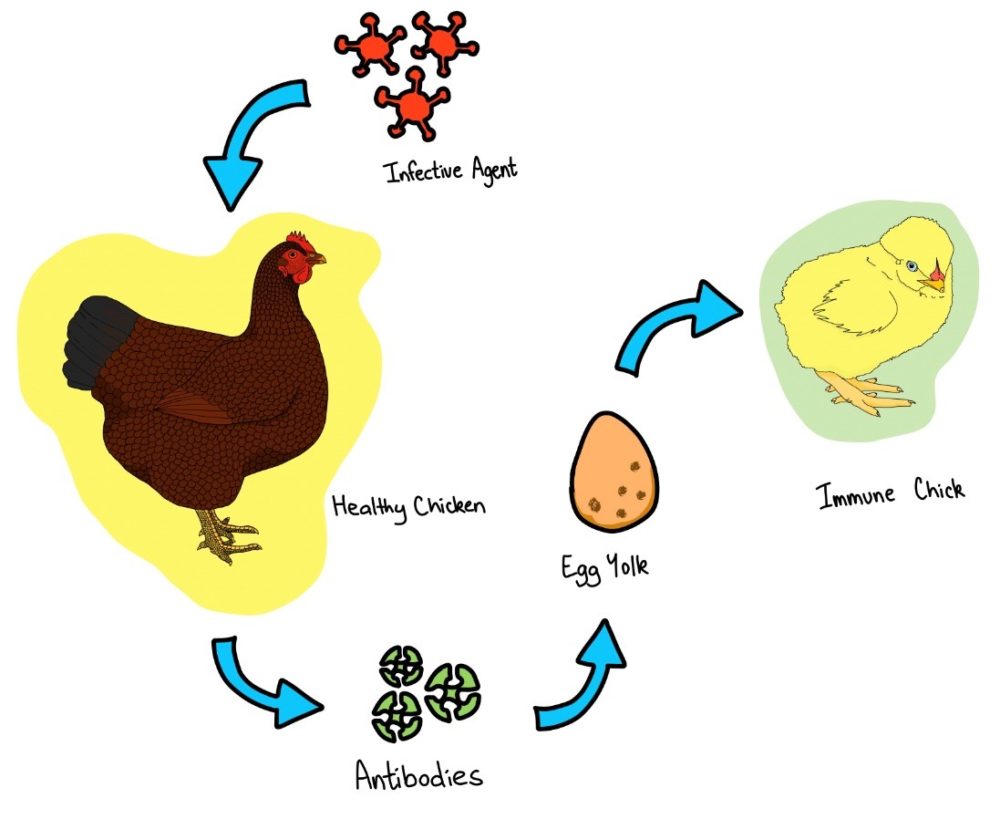Boosting Immunity in Your Flock
Whether you’re a serious breeder or just love watching your girls forage around the backyard, find out how to look after your chicken’s immune system!
What does the immune system do?
The immune system contains a variety of cells and mechanisms that defend the body against present and future diseases. When an infectious agent (such as a virus or bacteria) invades your chicken’s body, the immune system acts to destroy it. Once it has destroyed the intruding agent, it creates unique antibodies which can be used to specifically target and destroy future infections from the insulting pathogen.
Different types of immunity 
Passive – Good immunity in your flock starts with the hen, who transfers her antibodies onto her chicks through the egg yolk. These antibodies protect the chick for its first week of life whilst it establishes its own immune system.
Active – This is when the chicken’s own immune system defends the body against new infections. This can be due to infectious agents from the chicken’s environment or artificially through vaccinations.
What is a carrier chicken?
A carrier chicken is a bird that is not clinically sick but acts as a reservoir for a certain pathogen, shedding it to others in your flock. If this chicken becomes stressed it can become sick too. Unfortunately, many chicken diseases leave the birds being carriers for life and as culling your birds is not a viable option, we need to learn how to manage the presence of these disease in our flocks.

Are my flock harbouring diseases?
There are many diseases that are common within backyard flocks, and chances are your girls have one or multiple of the following. Thankfully, most flocks seem to cope well with many of the respiratory diseases, with only immunocompromised hens showing signs of sickness. If you feed and manage your chickens well, there’s a good chance you’ll hardly lose a chicken or see disease within your flock.
| Disease | What it usually looks like and problems it causes | How it spreads |
| Avian Mycoplasmosis
Three main strains are: – M. meleagridis (MM) – M. gallisepticum (MG) – M. synoviae (MS) |
o MM – decreases hatchability of eggs, respiratory infection in chicks that hatch
o MG – respiratory disease and decreases egg production o MS – infected joints and reduces eggshell quality |
o Bird to bird contact
o Hatching eggs from infected parents o Carriers for life
|
| Fowl Coryza | o Enlarged head with puffy eyes and swollen sinuses
o Sleepiness |
o Fast spread
o Bird to bird contact o Carriers for life |
| Fowl Cholera
Turkeys highly susceptible! This organism also causes bumblefoot! |
o Rapid Form: kills birds in few hours, sudden death
o Slow Form: swelling of comb and wattles (or foot pad) |
o Found in soil
o Bird to bird contact
|
| Infectious Bronchitis (IB) | o Can affect respiratory, urinary and reproductive systems
o Misshapen eggs, soft shelled eggs, different sizes and shape, albumin watery |
o Bird to bird contact
o Carriers for life o Fast spread, many deaths |
| Infectious Laryngotracheitis (ILT)
NOTIFIABLE DISEASE (please contact your veterinarian if you suspect this) |
o Herpes virus causing latent infections
o Mild Form: open mouth breathing, conjunctivitis and throat infection o Severe Form: Coughing up bloody/cheesy mucous |
o Bird to bird contact, vaccinated birds, infected equipment/environment
o Carrier birds for life o Slow spread o Present in most of Victoria and NSW |
| Fowl Pox | o Dry Form: scabbing of the skin on the comb, wattles and face
o Wet Form: Scabbing in the oral cavity |
o Through open wounds and mosquito/mite bites or inhaled dust particles |
| Chronic Respiratory Disease (CRD) | o Combination of respiratory signs
o Caused by multiple factors including E. coli, stress, Mycoplasma, IB, suppressed immune system |
o Multiple possibilities |
| Brooder Pneumonia
Aspergillus fumigatus
|
o In chicks: open mouth breathing, gasping, lethargy, death in first week after hatching
|
o Dirty eggs, contaminated chick fluff, poor disinfection of incubator
o Not spread from bird to bird |
| Marek’s Disease | o Progressive weakness and paralysis leading to death
o Eye colour change (iris becomes grey) and shrinking of pupil o Enlarged reddened skin around feather follicles |
o Spread through contaminated bedding and feather dander
o Carriers for life o Multiple strains |
| Lymphoid Leukosis | o Reduced weight gain, weakness and anorexia (very similar to Marek’s disease presentation) leading to death | o Usually occurs from 5 months of age
o Spread through eggs and infected chicks |
How can you improve immunity?
Keeping your flock healthy will give their immune system the best chance of responding to diseases. This can be done through:
- Providing a balanced diet that supports gut health
- Lowering stress
- Reducing environmental disease burden
To give your chickens an extra boost during stressful events (such as showing, moulting or extreme weather events), supportive feeds such as Barastoc Golden Yolk can be fed. This product now contains probiotics to assist with maintaining optimal gut microflora and thus keeps your chickens healthy and happy. Additional vitamins and minerals can also be added to your bird’s drinking water depending on what diet your chickens are fed.
By Breanna Carr, 5th Year Veterinary Science Student

